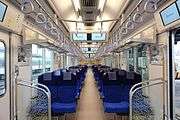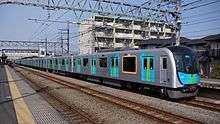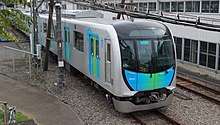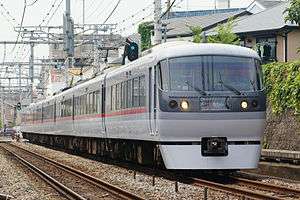Seibu 40000 series
| Seibu 40000 series | |
|---|---|
 40000 series set 40103 on an S-Train service in March 2018 | |
| Manufacturer | Kawasaki Heavy Industries |
| Built at | Kobe |
| Constructed | 2016- |
| Entered service | 25 March 2017 |
| Number under construction | 20 vehicles (2 sets) |
| Number built | 60 vehicles (6 sets) (as of February 2018) |
| Number in service | 20 vehicles (2 sets) |
| Formation | 10 cars per trainset |
| Fleet numbers | 40101- |
| Operator(s) | Seibu Railway |
| Line(s) served | |
| Specifications | |
| Car body construction | Aluminium alloy |
| Car length |
|
| Width | 2,808 mm (9 ft 2.6 in) |
| Height | 4,050 mm (13 ft 3 in) |
| Doors | 4 pairs per side |
| Maximum speed | 120 km/h (75 mph) |
| Traction system | Variable frequency (PMSM) |
| Acceleration | 3.3 km/h/s |
| Deceleration |
3.5 km/h/s (service) 4.5 km/h/s (emergency) |
| Electric system(s) | 1,500 V DC |
| Current collection method | Overhead catenary |
| Track gauge | 1,067 mm (3 ft 6 in) |
The Seibu 40000 series (西武40000系) is a commuter electric multiple unit (EMU) train type operated by the private railway operator Seibu Railway in Japan since March 2017.[1] A total of eight ten-car trainsets are to be built by Kawasaki Heavy Industries in Kobe from 2016, with the first trains entering service on 25 March 2017.[2]
Design
The new 40000 series trains were built by Kawasaki Heavy Industries in Kobe from January 2016, with deliveries scheduled to continue from fiscal 2016 to 2019.[3] This is the first time that trains for Seibu Railway have been built by this manufacturer.[3]
The new trains are designed as an evolution of the 30000 series "Smile Train" concept, and are intended to be passenger-friendly.[1] The trains use PMSM (permanent magnet synchronous motors).[1]
Operations
The 40000 series trains operate on Seibu Ikebukuro Line, Seibu Shinjuku Line, and Seibu Haijima Line services.[4] Some trainsets operate on reserved-seat supplementary-fare S-Train services between the Seibu Ikebukuro Line and Tokyo Metro Yurakucho Line on weekdays and between the Seibu Chichibu Line and Minato Mirai Line (via the Tokyo Metro Fukutoshin Line and Tokyu Toyoko Line) at weekends since 25 March 2017.[5][6]
Formation
The 40000 series EMUs are ten-car sets formed as follows, with five motored ("M") cars and five non-powered trailer ("T") cars, and car 1 at the Hanno (i.e. northern) end.[2]
| Car No. | 1 | 2 | 3 | 4 | 5 | 6 | 7 | 8 | 9 | 10 |
|---|---|---|---|---|---|---|---|---|---|---|
| Designation | Tc1 | M1 | M2 | T1 | M3 | T2 | T3 | M5 | M6 | Tc2 |
| Numbering | 4010x | 4020x | 4030x | 4040x | 4050x | 4060x | 4070x | 4080x | 4090x | 4000x |
| Weight (t) | 29.5 | 36.9 | 35.0 | 28.2 | 34.6 | 26.7 | 27.2 | 37.0 | 34.8 | 28.6 |
| Capacity (total/seated) longitudinal config. |
124/38 | 132/45 | 132/48 | 126/42 | 132/48 | 132/48 | 132/48 | 132/48 | 132/45 | 125/30 |
| Capacity (total/seated) transverse config. |
119/38 | 127/45 | 127/48 | 121/42 | 127/48 | 127/48 | 127/48 | 127/48 | 127/45 | 121/30 |
Cars 2, 5, and 8 each have one single-arm pantograph.[2] Car 4 has a universal access toilet.[2]
Interior
Passenger accommodation consists of longitudinal bench seating, but some trainsets feature rotating pairs of seats that can be arranged in either longitudinal or transverse arrangements.[1] LED lighting is used in the interiors, and pairs of LCD passenger information screens are provided both above the doorways and suspended form the ceilings.[2] A "Partner zone" area is provided at the end of car 10 with perch seats and space for wheelchairs and large luggage.[2] This area also has larger windows.[2] "Plasmacluster" air-purification technology is used for the first time on Seibu Railway trains.[4]
 The interior of a 40000 series set in March 2017 with seating in transverse configuration
The interior of a 40000 series set in March 2017 with seating in transverse configuration Three-person seating at the end of a car in March 2017
Three-person seating at the end of a car in March 2017 The "Partner zone" standing area in car 10 in April 2017
The "Partner zone" standing area in car 10 in April 2017 Ceiling-mounted "Smile Vision" LCD passenger information display screens
Ceiling-mounted "Smile Vision" LCD passenger information display screens The train toilet in April 2017
The train toilet in April 2017
History

Details of the new trains were officially announced in August 2015.[1] The first trainset, 40101, was delivered from the Kawasaki Heavy Industries factory in Kobe to Seibu's Kotesashi Depot in September 2016.[7]
The first sets entered revenue service on S-Train services on 25 March 2017.[8]
From spring 2018, 40000 series trains are scheduled to be used on new Haijima Liner (拝島ライナー) limited-stop supplementary-fare commuter services operating from Seibu-Shinjuku to Haijima on weekday evenings.[9]
Build histories

The manufacturers and delivery dates for the fleet are as shown below.[8]
| Set No. | Manufacturer | Date delivered |
|---|---|---|
| 40101 | Kawasaki Heavy Industries | 10 January 2017[Note 1] |
| 40102 | Kawasaki Heavy Industries | 11 January 2017[Note 1] |
| 40103 | Kawasaki Heavy Industries | October 2017[10] |
| 40104 | Kawasaki Heavy Industries | November 2017[11] |
| 40105 | Kawasaki Heavy Industries | January 2018[12] |
| 40106 | Kawasaki Heavy Industries | February 2018[13] |
| 40107 | ||
| 40108 |
- Notes
See also
- Tobu 50090 series, a Tobu Railway commuter EMU type that also features rotating longitudinal/transverse seating
- Keio 5000 series (2017), a Keio commuter EMU type that also features rotating longitudinal/transverse seating
References
- 1 2 3 4 5 西武鉄道、新型通勤車両「40000系」を導入へ 初の「パートナーゾーン」も設置 [Seibu Railway to introduce new 40000 series commuter trains - Will include "partner zone" for first time] (in Japanese). Japan: Tetsudo Shimbun. 24 August 2015. Archived from the original on 4 March 2016. Retrieved 12 September 2016.
- 1 2 3 4 5 6 7 西武鉄道 40000系 [Seibu Railway 40000 series]. Japan Railfan Magazine (in Japanese). Vol. 57 no. 673. Japan: Koyusha Co., Ltd. May 2017. p. 74-79.
- 1 2 川崎重工、西武鉄道から新型車両「40000系」80両を受注 [Kawasaki Heavy Industries wins order for 80 new 40000 series vehicles from Seibu Railway] (in Japanese). Japan: Nikkan Kogyo Shimbun, Ltd. 25 August 2015. Archived from the original on 29 August 2015. Retrieved 12 September 2016.
- 1 2 進化した”スマイルトレイン” 西武鉄道、新型車両「40000系」デビューへ [New Seibu 40000 series "advanced Smile train" rolling stock to debut] (in Japanese). Japan: Tetsudo Shimbun. 24 August 2015. Archived from the original on 3 August 2016. Retrieved 12 September 2016.
- ↑ 西武・メトロ・東急、座席指定制の直通列車を2017年春に導入へ [Seibu, Tokyo Metro, and Tokyu to introduce reserved-seat through trains in spring 2017] (in Japanese). Japan. 16 June 2016. Archived from the original on 16 June 2016. Retrieved 16 June 2016.
- ↑ 西武・メトロ・東急 座席指定直通列車の愛称など決定 [Name decided for Seibu/Tokyo Metro/Tokyu reserved-seat through-running train]. Tetsudo.com (in Japanese). Japan: Asahi Interactive Inc. 11 January 2017. Retrieved 11 January 2017.
- ↑ 40000系 小手指車両基地へ到着 [Seibu 40000 series arrives at Kotesashi Depot]. RM News (in Japanese). Japan: Neko Publishing. 12 September 2016. Archived from the original on 12 September 2016. Retrieved 12 September 2016.
- 1 2 私鉄車両編成表 2017 私鉄車両編成表 2017 [Private Railway Rolling Stock Formations - 2017] (in Japanese). Japan: Kotsu Shimbunsha. 25 July 2017. p. 48. ISBN 978-4-330-81317-2.
- ↑ 西武40000系第3編成が甲種輸送される [Third Seibu 40000 series set delivered]. Japan Railfan Magazine Online (in Japanese). Japan: Koyusha Co., Ltd. 14 October 2017. Archived from the original on 19 October 2017. Retrieved 21 November 2017.
- ↑ 西武40000系第4編成が甲種輸送される [Fourth Seibu 40000 series set delivered]. Japan Railfan Magazine Online (in Japanese). Japan: Koyusha Co., Ltd. 12 November 2017. Archived from the original on 16 November 2017. Retrieved 21 November 2017.
- ↑ 西武40000系第5編成が甲種輸送される [Fifth Seibu 40000 series set delivered]. Japan Railfan Magazine Online (in Japanese). Japan: Koyusha Co., Ltd. 27 January 2018. Archived from the original on 19 February 2018. Retrieved 19 February 2018.
- ↑ 西武40000系第6編成が甲種輸送される [Sixth Seibu 40000 series set delivered]. Japan Railfan Magazine Online (in Japanese). Japan: Koyusha Co., Ltd. 18 February 2018. Archived from the original on 19 February 2018. Retrieved 19 February 2018.
External links
| Wikimedia Commons has media related to Seibu 40000 series. |
- Official news release (in Japanese)
- Kawasaki Heavy Industries press release (in Japanese)
